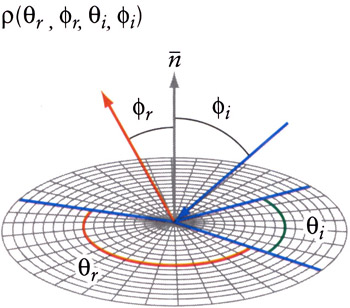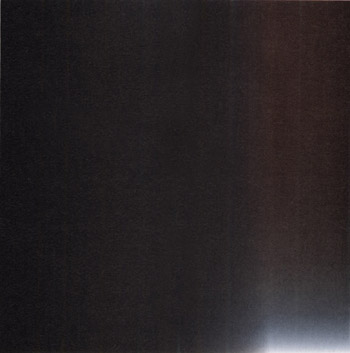THE BIDIRECTIONAL REFLECTANCE DISTRIBUTION FUNCTION (BRDF)
|
|
We're trying to accurately simulate reflectance from light traveling through a dielectric (something transparent, air, vacuum, etc.) and hitting the surface of a conductor (or something nontransparent) and reflecting off that surface.
The bidirectional reflectance distribution function (BRDF) takes into account the structure of the reflecting surface, the attenuation of the incident light by that structure, and the optical properties of the surface. It relates the incident light energy with the outgoing light energy. The incoming and outgoing light rays need to have not only their angles with the surface normal considered, but also the orientation of the rays with the surface orientation. This allows surfaces that reflect light differently, depending on their orientation around the surface normal (i.e., an isotropic surface), to be modeled.
Figure 3.35 shows how the BRDF parameters relate to the surface normal and orientation of the surface. So a BRDF depends upon a total of four angles. Of course, you can simplify these by making assumptions about which terms are important to get the effect you want.

Figure 3.35: A BRDF is a function of an incident and reflection angle and two rotational angles.
BRDFs in Practice
The problem with BRDFs is that they are tough to implement in a practical manner. It's perfectly fine to have a BRDF that's expensive to calculate if you are doing some non-real-time imagery, but for performing BRDFs in shaders, you frequently have to simplify the model. The Lambertian model for diffuse reflection, for example, can be considered a BRDF that's just a constant. Phong's illumination model takes the (typical) approach of breaking a BRDF into diffuse and specular parts. It uses the Lambertian model for the diffuse and a cosθ term for the specular, treating the specular BRDF as a function of the incident light vertex normal angle only.
However, we've already tried these models and found them wanting, so we'll take a look at a model for specular reflection developed by Blinn [BLINN 1977] that is still popular. Blinn proposed that, using the Cook-Torrance model for surface geometry, the specular reflection is composed of four parts.
-
The distribution function, D.
-
The Fresnel reflection law, F.
-
The geometric attenuation factor, G.
-
The fraction of the microfacets that are visible to the light and the viewer by a (n • v)(n • l) term.
The BRDF specular function is then

Now we've already gone though the Fresnel term, the distribution function, and the geometric attenuation factor. You're free to make these as complicated as you like. For example, Blinn leaves the Fresnel term = 1, whereas Cook-Torrance doesn't.
It's possible to precompute the BRDF by judiciously choosing some of the parameters, and then generating one or more textures to account for the other terms. Typically, you might generate a texture where the u, v values of the texture are mapped to the n • v and n • l terms. For more information on BRDF factorization, you can refer to [ENGEL 2002] and [LENGYEL 2002]. Figure 3.36 shows a BRDF reduced to those two terms.

Figure 3.36: A precomputed BRDF texture using the values for gold.
Anisotropic Reflection
One interesting feature of the BRDF is that is supports anisotropic reflection, that is, reflection that varies in strength depending upon the orientation of the material's surface. Many surfaces exhibit this type of shading: hair, brushed metal, grooved surfaces (CDs, records), some fabrics, etc. Some of the more complex BRDFs can model the effects.
Poulin-Fournier [POULIN 1990] wrote one of the earliest papers on anisotropic reflection models. The Poulin-Fourier model replaced the randomly oriented v-shaped grooves of the Torrance-Sparrow model with aligned cylindrical shapes (either grooves or protrusions). He, Torrance, Sillion, and Greenberg [HE 1991] proposed a model where they broke the specular term into two parts, a diffuse specular and a directional specular. Their full model is quite complex and can be used with polarized light. Even the unpolarized simplified equations are quite complex and would be nearly impossible to fit inside a shader. In a latter paper [HE 1992], they address issues of computational speed, and in a time-honored tradition, compute a lookup table from which they can closely reproduce the values in their original paper. A different approach was taken by Ward [WARD 1992], who proposed finding the simplest empirical mode that would fit the data. This is still a very active area of research. Figure 3.37 shows some work on anisotropic BRDFs from [ASHIKHMIN 2000]. Many papers in Siggraph Proceedings of recent years are worth looking into if you are interested in seeing further details and research. [BRDF] lists some online BRDF databases.

Figure 3.37: Illustrating different anisotropic features.
|
|
EAN: 2147483647
Pages: 104